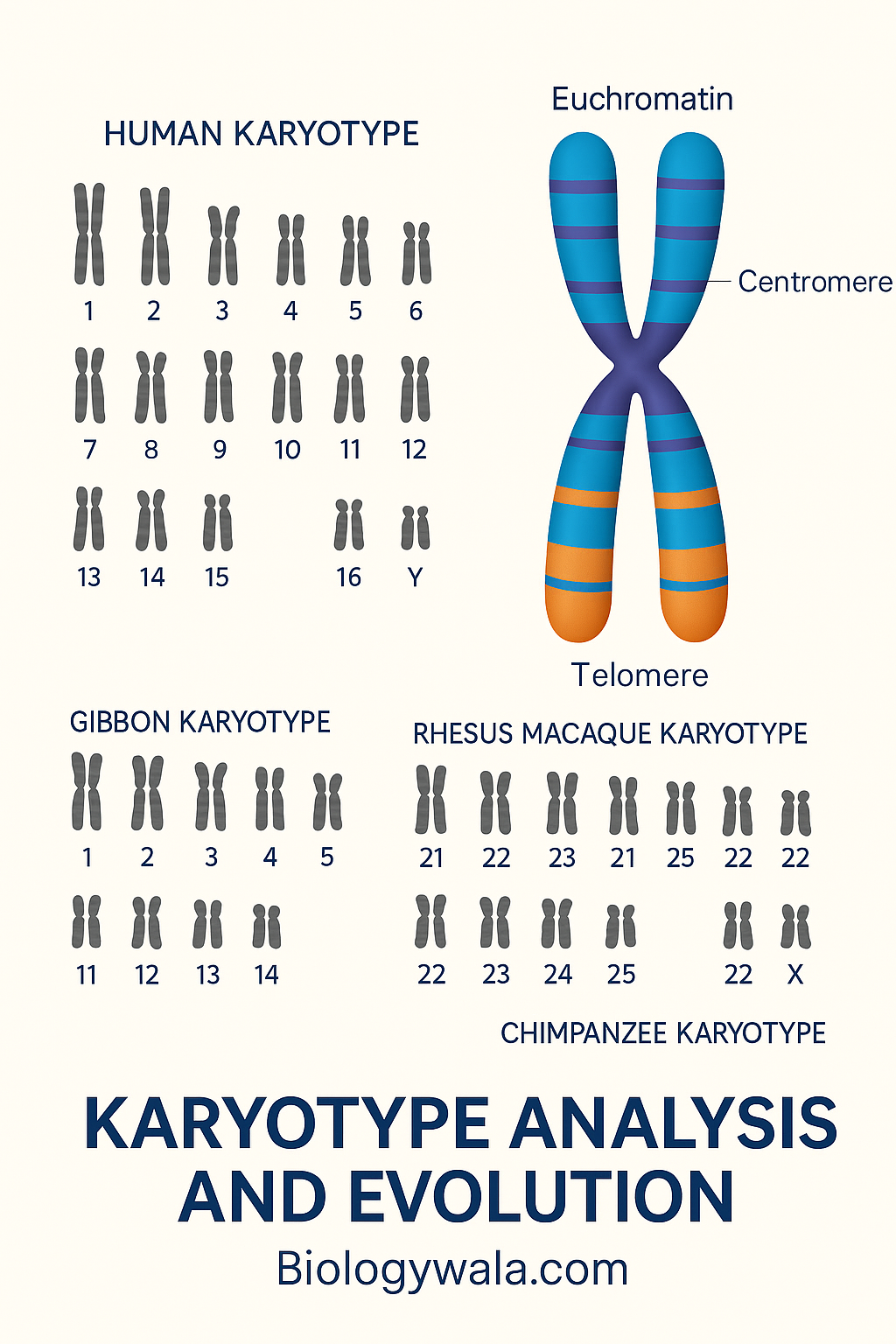Karyotype Analysis and Evolution

A karyotype is the complete set of chromosomes of an organism, arranged in pairs and ordered by size, shape, and centromere position.
It represents the chromosomal constitution (number and morphology) of a cell and is crucial for studying genetic stability, evolution, and taxonomy. here we will discuss about Karyotype Analysis and Evolution
2. Karyotype Analysis
Definition
Karyotype analysis is the microscopic examination and arrangement of chromosomes from a metaphase spread to determine their number, size, morphology, and abnormalities.
Steps in Karyotype Preparation
- Cell Collection: Usually from bone marrow, root tips, or cultured lymphocytes.
- Cell Division Arrest: Treated with colchicine to stop at metaphase.
- Hypotonic Treatment: Swells cells for chromosome spreading.
- Fixation and Staining: With Giemsa, Quinacrine, or Fluorescent dyes (banding techniques).
- Photomicrography and Arrangement: Chromosomes arranged into homologous pairs (1–22 autosomes + sex chromosomes in humans).
Chromosome Morphology
Each chromosome is characterized by:
- Length of arms (p and q)
- Centromere position: metacentric, submetacentric, acrocentric, telocentric.
- Secondary constrictions and satellites
- Banding pattern (G-, Q-, R-, C-bands)
Karyotype Ideogram
An ideogram is a schematic diagram showing relative sizes and centromere positions of chromosomes, useful for comparative and diagnostic studies.
Applications of Karyotype Analysis
- Detection of chromosomal abnormalities (e.g., Down’s, Turner’s, Klinefelter’s syndromes).
- Understanding taxonomic relationships and species differentiation.
- Tracing polyploidy and hybridization events.
- Identifying sex chromosomes and structural mutations (deletions, inversions, translocations).
3. Karyotype and Evolution
Evolutionary Significance
Karyotype evolution refers to changes in chromosome number and structure that occur during the evolution of species.
These changes play a major role in speciation and adaptation.
Mechanisms of Karyotype Evolution
| Mechanism | Description / Effect |
| Aneuploidy | Gain or loss of single chromosomes → numerical variation. |
| Polyploidy | Duplication of the entire chromosome set; common in plants, leading to speciation. |
| Chromosomal Fusions / Fissions | Structural rearrangements altering chromosome number (e.g., human chromosome 2 formed by fusion). |
| Inversions & Translocations | Rearrangements altering gene linkage and recombination rates. |
| B-Chromosomes | Extra, non-essential chromosomes contributing to intraspecific variation. |
Trends in Karyotype Evolution
- Symmetrical Karyotype → All chromosomes similar in size and shape (ancestral).
- Asymmetrical Karyotype → Unequal sizes and varied centromere positions (advanced).
- Increasing asymmetry reflects specialization and evolutionary advancement.
Role in Plant and Animal Evolution
- In plants, polyploidy and hybridization accelerate speciation (e.g., Wheat, Brassica).
- In animals, structural changes (fusion, fission) contribute to divergence (e.g., human–chimp chromosome differences).Karyotype analysis provides insights into chromosomal organization, species relationships, and evolutionary trends.
Through numerical and structural variations, chromosomes serve as molecular markers of evolution, linking cytogenetics with evolutionary biology.
Join SACHIN’S BIOLOGY on Instagram or Facebook to receive timely updates and important notes about exams directly on your mobile device. Connect with Mr. Sachin Chavan, the founder of Sachin’s Biology and author of biologywala.com, who holds an M.Sc., NET JRF (AIR 21), and GATE qualifications. With SACHIN’S BIOLOGY, you can have a direct conversation with a knowledgeable and experienced professional in the field of biology. Don’t miss out on this opportunity to enhance your exam preparation!
![Brock Biology of Microorganisms | Brock biology of microorganisms 15th edition review 2 [DOWNLOAD] FREE Brock Biology of Microorganisms eBook PDF | Brock biology of microorganisms 15th edition PDF](https://biologywala.com/wp-content/uploads/2021/11/Copy-of-Copy-of-Download-Campbell-Biology-1-520x245.png)

![[Download] Free Microbiology An Introduction Book PDF 13th Edition 4 [Download] Free Microbiology An Introduction Book PDF 13 th Edition](https://biologywala.com/wp-content/uploads/2021/08/Download-Microbiology-An-Introduction-Book-PDF-13th-Edition-1-520x245.png)